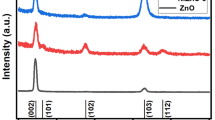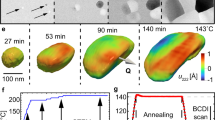Abstract
Textures, stresses, and strains, as well as the overall so-called real structure, are crucial for properties of thin films deposited by different methods and can have both positive and negative effects depending on the film and its application. They were studied by a combination of different X-ray diffraction (XRD) techniques for several ZnO films. The films prepared by pulsed laser deposition (PLD) on MgO and sapphire single-crystalline substrates and amorphous-fused silica showed different kinds of strong preferred orientation and also different stresses that could be estimated only from the analysis of quite narrow, nonzero intensity regions of diffraction spots. XRD line broadening was analyzed by a combination of different asymmetric scans. Fiber (0001) texture and tensile residual stresses were found on fused silica, while domains with local epitaxy and huge compressive stress were detected on MgO substrate, and surprisingly, very strong local epitaxy but not parallel to the (0001) sapphire substrate was observed. No residual stress was detected there. Some methodological aspects of the XRD studies of thin nanocrystalline films with strong preferred orientation are discussed.


















Similar content being viewed by others
Notes
This is even more strictly fulfilled for the parallel beam while in the parafocusing geometry instrumental aberrations result in nonzero contributions also from slightly inclined planes.
In this article, 4-index notation is used for hexagonal planes, but 3-index notation for the diffraction lines is used commonly in powder diffraction.
References
A. Jain, P. Sagar, and R.M. Mehra: Solid State Electron., 2006, vol. 50, p. 1420–24.
D.P. Norton: Mater. Sci. Eng. R, 2004, vol. 43, p. 139–247.
S.J. Pearton, D.P. Norton, K.I.Y.W. Heo, and T. Steiner: Progr. Mater. Sci., 2005, vol. 50, p. 293.
A. Janotti and C.G. Van deWalle: Rep. Prog. Phys., 2009, vol. 72, p. 126501.
K. Ellmer, A. Klein, and B. Rech: Transparent and Conductive Zinc Oxide, Basics and Applications, Springer Series in Materials Science, vol. 104, Springer, New York, 2008.
H. Morkoç and Ü. Özgrür: Zinc Oxide, Fundamentals, Materials and Device Technology, Wiley, New York, NY, 2009.
J.C. Nie, J.Y. Yang, Y. Piao, H.Li, Y. Sun, Q.M. Xue, C.M. Xiong, R.F. Dou, and Q.Y. Tu: Appl. Phys. Lett., 2008, vol. 93, p. 173104.
R. Eason: Pulsed Laser Deposition of Thin Films. Applications. Led Growth of Functional Materials, Wiley, Hoboken, NJ, 2007.
M. Birkholz: Thin Film Analysis by X-Ray Scattering, Wiley, Weinheim, Germany, 2006.
C.V. Thomson and R. Carel: Mater. Sci. Forum, 1996, vols. 204–206, pp. 83–98.
N. Kaiser: Appl. Optic., 2002, vol. 41, pp. 3053–60.
Z. Cao: Thin Film Growth. Physics, Woodhead Publishing Limited, China, 2001.
M. Ohring: Materials Science of Thin Films, 2nd ed., Academic Press, Atlanta, GA, 2001.
L.B. Freund and S. Suresh: Thin Film Materials: Stress, Defect Formation and Surface Evolution, Cambridge University Press, New York, NY, 2009.
M. Suchea, S. Christoulakis, M. Katharakis, G. Kiriakidis, N. Katsarakis, and E. Koudoumas: Appl.Surf. Sci., 2007, vol. 253, pp. 8141–45.
J.M. Myoung, W.H. Yoon, D.H. Lee, I. Yun, S.H. Bae, and S.Y. Lee: Jpn. J. Appl. Phys., 2002, vol. 41, pp. 28–31.
M. Novotny, J. Cizek, R. Kuzel, J. Bulir, J. Lancok, J. Connolly, E. McCarthy, S. Krishnamurthy, and J.P. Mosnier: J. Phys. D, 2012, vol. 45 (22), 225101.
R. Kužel, R. Černý, V. Valvoda, M. Blomberg, and M. Merisalo: Thin Solid Films, 1994, vol. 247, pp. 64–78.
J. Rodriguez-Carvajal: Phys. B, 1993, vol. 192, p. 55.
A.C. Larson and R.B. Von Dreele: “General Structure Analysis System (GSAS)”, Los Alamos National Laboratory Report LAUR, 1994, pp. 86–748, http://www.ccp14.ac.uk/solution/gsas/.
P. Scardi and M. Leoni: J. Appl. Crystallogr., 2006, vol. 39, pp. 24–31.
G. Ribárik, T. Ungár, and J. Gubicza: J. Appl. Crystallogr., 2001, vol. 34, pp. 669–76.
L. Lutterotti: Nucl. Instrum. Methods Phys. Res., B, 2010, vol. 268, pp. 334–40.
L. Lutterotti, D. Chateigner, S. Ferrari, and J. Ricote: Thin Solid Films, 2004, vol. 450, pp. 34–41.
Z. Matěj, R. Kužel, and L. Nichtová: Powder Diffr., 2010, vol. 25, pp. 125–31.
I.C. Noyan and J.B. Cohen: Residual Stress Measurement by X-Ray Diffraction and Interpretation, Springer, Berlin, Germany, 1987.
M. Klaus, C. Genzel, and H. Holzschuh: Thin Solid Films, 2008, vol. 517, pp. 1172–76.
H. Behnken and V. Hauk: Mater. Sci. Eng. A, 2001, vol. 300, pp. 41–51.
A. Kumar, U.Welzel, and E.J. Mittemeijer: J. Appl. Crystallogr., 2006, vol. 39, pp. 633–46.
U. Welzel, J. Ligot, P. Lamparter, A.C. Vermeulen, and E.J. Mittemeijer: J. Appl. Crystallogr., 2005, vol. 38, pp. 1–29.
C.M. Brakman: J. Appl. Crystallogr., 1983, vol. 16, pp. 325–40.
C.M. Brakman: Acta Crystallogr. A, 1987, vol. 43, pp. 270–83.
M. Barral, J.L. Lebrun, J.M. Sprauel, and G. Maeder: Metall. Trans. A, 1987, vol. 18A, pp. 1229–38.
D. Chateigner: Combined Analysis, Wiley, New York, NY, 2010.
V. Randle and O. Engler: Introduction to Texture Analysis: Macrotexture, Microtexture and Orientation Mapping, CRC Press, Boca Raton, FL, 2009.
C. Dong and J.I. Langford: J. Appl. Crystallogr., 2000, vol. 33, pp. 1127–79.
Inorganic Crystal Structure Database, FIZ Karlsruhe, http://www.fiz-karlsruhe.de/icsd.html.
Powder Diffraction File, PDF-4, International Centre for Diffraction Data http://www.icdd.com.
Pearson’s Crystal Data, Crystal Impact, http://www.crystalimpact.com.
G.C. Gadzhiev: High Temp., 2003, vol. 41, pp. 778–82.
P. Fons, K. Iwata, S. Niki, A. Yamada, and K. Matsubara: J. Cryst. Growth, 1999, vols. 201–202, pp. 627–632.
Y. Chen, D.M. Bagnall, H.-J. Koh, K.-T. Park, K. Hiraga, Z.-Q. Zhu, and T. Yao: J. Appl. Phys., 1998, vol. 84, p. 3912.
Acknowledgments
The work is supported by the Grant Agency of the Czech Republic under the numbers P108/11/1539 and P108/11/0958.
Author information
Authors and Affiliations
Corresponding author
Additional information
Manuscript submitted April 16, 2012.
Rights and permissions
About this article
Cite this article
Kužel, R., Čížek, J. & Novotný, M. On X-Ray Diffraction Study of Microstructure of ZnO Thin Nanocrystalline Films with Strong Preferred Grain Orientation. Metall Mater Trans A 44, 45–57 (2013). https://doi.org/10.1007/s11661-012-1432-x
Published:
Issue Date:
DOI: https://doi.org/10.1007/s11661-012-1432-x




